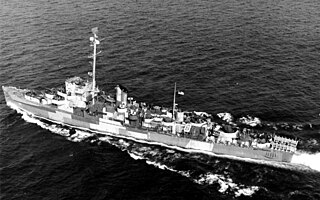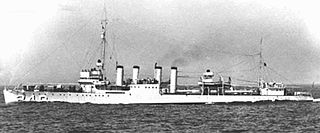This page is based on this
Wikipedia article Text is available under the
CC BY-SA 4.0 license; additional terms may apply.
Images, videos and audio are available under their respective licenses.

The Arleigh Burke class of guided missile destroyers (DDGs) is the United States Navy's first class of destroyer built around the Aegis Combat System and the SPY-1D multifunction passive electronically scanned array radar. The class is named for Admiral Arleigh Burke, an American destroyer officer in World War II, and later Chief of Naval Operations. The class leader, USS Arleigh Burke, was commissioned during Admiral Burke's lifetime.

The Boston Navy Yard, originally called the Charlestown Navy Yard and later Boston Naval Shipyard, was one of the oldest shipbuilding facilities in the United States Navy. It was established in 1801 as part of the recent establishment of the new U.S. Department of the Navy in 1798. After 175 years of military service, it was decommissioned as a naval installation on 1 July 1974.

A guided-missile destroyer is a destroyer designed to launch guided missiles. Many are also equipped to carry out anti-submarine, anti-air, and anti-surface operations. The NATO standard designation for these vessels is DDG. Nations vary in their use of destroyer D designation in their hull pennant numbering, either prefixing or dropping it altogether. The U.S. Navy has adopted the classification DDG in the American hull classification system.

The Kidd-class destroyers were a series of four guided missile destroyers (DDGs) based on the Spruance class. The Kidds were designed as more advanced multipurpose ships, in contrast to their predecessor's focus on anti-submarine warfare, adding considerably enhanced anti-aircraft capabilities. Originally ordered for the former Imperial Iranian Navy, the contracts were canceled when the 1979 Iranian Revolution began, and the ships were completed for the United States Navy. Because they were equipped with heavy-duty air conditioning and other features that made them suitable in hot climates, they tended to be used in the Middle East, specifically the Persian Gulf itself. During their service with the U.S. Navy from the 1980s to the late 1990s, the ships were popularly known as the "Ayatollah" class. They were decommissioned and sold to the Republic of China Navy as the Kee Lung class.

USS Knox (DE-1052/FF-1052) was the prototype and lead ship in a new class of destroyer escorts in the United States Navy. She was named for Commodore Dudley Wright Knox and was the second US Navy ship named USS Knox.

The Evarts-class destroyer escorts were destroyer escorts launched in the United States in 1942–44. They served in World War II as convoy escorts and anti-submarine warfare ships. They were also known as the GMT or "short hull" DE class, with GMT standing for General Motors Tandem Diesel drive.

The Gleaves-class destroyers were a class of 66 destroyers of the United States Navy built 1938–42, designed by Gibbs & Cox. The first ship of the class was USS Gleaves. They were the production destroyer of the US Navy when it entered World War II.

USS Turner (DD-648), was a Gleaves-class destroyer of the United States Navy. She was commissioned on 15 April 1943 and sank after suffering internal explosions on 3 January 1944.

USS Corry (DD-334) was a United States Navy Clemson-class destroyer launched and commissioned in 1921.

The John C. Butler class were destroyer escorts that originated during World War II. The lead ship was USS John C. Butler, commissioned on 31 March 1944. The class was also known as the WGT type from their Westinghouse geared turbine drive.
Of the 293 ships originally planned, 206 were canceled in 1944 and a further four after being laid down; three were not completed until after the end of World War II.

The Edsall-class destroyer escorts were destroyer escorts built primarily for ocean antisubmarine escort service during World War II. The lead ship, USS Edsall, was commissioned on 10 April 1943 at Orange, Texas. The class was also known as the FMR type from their Fairbanks-Morse reduction-geared diesel drive, with a type of engine used in the submarines of the time. The FMR's substitution for a diesel-electric power plant was the essential difference from the predecessor Cannon ("DET") class. This was the only World War II destroyer escort class in which all the ships originally ordered were completed as United States Navy destroyer escorts. Destroyer escorts were regular companions escorting the vulnerable cargo ships. Late in the war, plans were made to replace the 3-inch (76 mm) guns with 5-inch (127 mm) guns, but only Camp was refitted. In total, all 85 were completed by two shipbuilding companies: Consolidated Steel Corporation, Orange, Texas (47), and Brown Shipbuilding, Houston, Texas (38). Most were en route to the Pacific Theater when Japan surrendered. One of the ships participated in Operation Dragoon and two were attacked by German guided missiles.

The Cannon class was a class of destroyer escorts built by the United States primarily for ocean antisubmarine warfare escort service during World War II. The lead ship, USS Cannon, was commissioned on 26 September 1943 at Wilmington, Delaware. Of the 116 ships ordered, 44 were cancelled and six were commissioned directly into the Free French Forces. Destroyer escorts were regular companions escorting the vulnerable cargo ships.

USS Jason Dunham (DDG-109) is an Arleigh Burke-class destroyer in the United States Navy. She is named after U.S. Marine Corps corporal Jason Dunham, who was posthumously awarded the Medal of Honor for service in the Iraq War.
USS Sturtevant (DE-239) was an Edsall class destroyer escort built for the U.S. Navy during World War II. She served in the Atlantic Ocean and the Pacific Ocean, and provided destroyer escort protection against submarine and air attack for Navy vessels and convoys.
Sheldon Hoard Kinney was a U.S. Navy rear admiral who was prominent for action in World War II, the Korean War, Vietnam and later maritime education as Commandant of Midshipmen at the U.S. Naval Academy, President of SUNY Maritime College and as the founder and President of the UN World Maritime University.

















